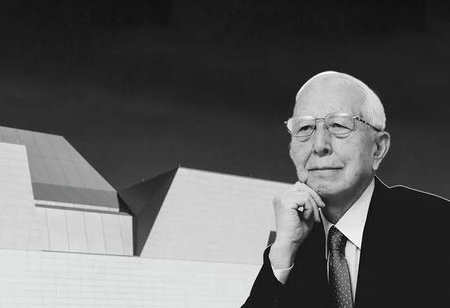
The Legacy of Fumihiko Maki is the Pillar of Japanese Modernism


Renowned Japanese architect Fumihiko Maki, known for his legacy in Japanese modernism, left the world on June 6th this year at his home in Tokyo. The Pritzker Prize-winning Metabolist is one of the pioneers of the metabolism movement, whose works remain as one of the first ever architectural innovations since World War II. His most acclaimed modernist architecture projects include the National Museum of Modern Art in Kyoto, the Aga Khan Museum in Toronto, the Tokyo Spiral, and the Four World Trade Center in New York.
Maki, who was born in 1928 in Tokyo, attended the Harvard University Graduate School of Design, the University of Tokyo, and the Cranbrook Academy of Art in Michigan for his education. Maki mastered his art by gaining many work experiences before founding his own design firm in Tokyo in 1965. These offices included the campus planning office of Washington University in St. Louis, Sert, Jackson & Associates in Cambridge, and Skidmore Owings and Merrill, or SOM, which was based in Chicago.
He is fondly remembered as a passionate teacher, who gave lectures all around the world besides teaching at Harvard, Washington University, and the University of Tokyo. His articles were published by the MIT Press in 2008, titled ‘Nurturing Dreams.’ He has examined the concept of "oku," which is a high-density environment in Japan that is "organized into multiple layers like an onion.”
Used Modernist Materials
Maki used a lot of concrete, glass, metal, and other conventional modernist materials in his works, which often seemed simple and even modest. He also added elements like stainless steel, anodized aluminum, and mosaic tile to the conventional color scheme.
One of the Pioneers of Metabolism in Architecture
Maki set out for adventure very early on in his professional life by joining the Metabolist School of Architecture, seeking structural answers to solve Japan's problems of growing cities. Maki suggested huge structures that may nevertheless have a sense of human scale in contrast to the intimidating "megastructures" that Tange and some of the other Metabolists had advocated. The best example of this is the Tokyo apartment complex Hillside Terrace Apartments, which he built in phases between 1967 and 1992.
Embraced Advancement in Construction and Material Science
During the metabolism movement, structures were characterized by their brutalist forms, comprising modern advancements in both construction and material science. The main aim was to find ways how architecture could develop and alter, becoming self-generating systems that could change as society did. The 1970 Osaka Expo, with Kisho Kurokawa's Toshiba IHP and Takara Pavilion designs and Kenzo Tange's Festival Plaza, may have been the best examples of the Metabolist design language.
But Maki Focused on Incorporating Humanism
Although one of the movement's central ideas was to combine technology and biology, Maki was more concerned with comprehending historic spatial patterns and incorporating them into the design to humanize the new city's unparalleled scale.
He concentrated more on the concept of communal form.
This is evident in his initiatives like Hillside Terrace, which offer a tangible representation of his career. The Hillside Terrace Apartment Complex in Tokyo was completed in seven phases between 1967 and 1992 and highlighted the architect's notion of progressive development. The design emphasizes the human through the integration of external and internal elements and its scale.
Turning Point of His Career
The architect's other noteworthy projects from this period include the Fujisawa Gymnasium (1980–84), which he saw as a turning point in his career.
In the era of megastructures, the architect stood out by taking human considerations into account. Even though he received the Pritzker Prize for developing a unique vocabulary that drew inspiration from his time spent in the West, it particularly recognizes his structures for including people, cultures, and technology. Remembering them means honoring their presence through their work, as is the case with most luminaries. "Over time, I have come to think of the buildings I have designed there as extensions of myself," Maki said in a post about Hillside. Perhaps the best way that his essence endures is via them.
Ever a Modernist
Maki frequently stated that, as a result of his mid-century studies in the US, he considered himself to be a Modernist. In contrast to many large-scale Modernist buildings, his constructions have a human scale. Maki used several levels of space instead of a single, dominating one to evoke the idea of secluded courtyards and garden areas—elements that are fundamental to Japanese architecture. Since Maki believed that these little, personal places would come together to produce an overall sense of community and harmony, this layout exemplifies his views about the interconnectedness of the parts and the whole.
Maki continued to experiment with his fusion of Modernism and Japanese heritage throughout the 1980s and 1990s. He explored the expressive possibilities of metal in his Fujisawa Gymnasium (1984), a vast stadium with a light-colored, airy stainless steel roof that appears to hover above the area. The airiness of the area reminds me of Japanese traditions, even though his exploration of materials and technology in the gymnasium is Modernist. He further investigated the potential of metal in his design for the Wacoal Art Centre (1982–1985) in Tokyo, producing an aluminum exterior with a variety of geometric shapes and textures. His Nippon Conference Centre (1990) in Tokyo, a massive conference center with a ground-level layout meant to feel personal, is evidence of his continued commitment to the human scale.

